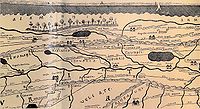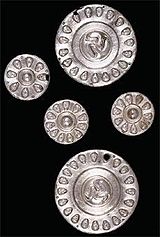- Cisalpine Gaul
-
This article is about the Roman province. For other uses of the word "Cisalpine", see Cisalpine (disambiguation).
Cisalpine Gaul, in Latin: Gallia Cisalpina or Citerior, also called Gallia Togata,[1] was a Roman province until 41 BC when it was merged into Roman Italy.[2]
It bore the name Gallia, because the great body of its inhabitants, after the expulsion of the Etruscans, consisted of Gauls or Celts.[3] The name Cisalpina denoted Gallia south of the Alps, as opposed to Transalpina, or Gallia north of the Alps.[4] The province was bounded in the north and west by the Alps, in the south as far as Placentia by the river Po, and then by the Apennines and the river Rubicon, and in the east by the Adriatic Sea.[3]
In 49 BC all inhabitants of Cisalpine Gaul received Roman Citizenship,[5] and eventually Cisalpine Gaul was split into the 11 Augustan regions of Italy: Regio VIII Gallia Cispadana,
Regio IX Liguria, Regio X Venetia et Histria and Regio XI Gallia Transpadana.[6]Contents
The Roman province
See also: Roman Republican governors of GaulSometimes referred to as Gallia Citerior ("Hither Gaul"), Provincia Ariminum, or Gallia Togata ("Toga-wearing Gaul", indicating the region's early Romanization). Gallia Transpadana denoted that part of Cisalpine Gaul between the Padus (now the Po River) and the Alps, while Gallia Cispadana was the part to the south of the river.
Probably officially established around 81 B.C., the province was governed from Mutina (modern-day Modena), where, in 73 B.C., forces under Spartacus defeated the legion of Gaius Cassius Longinus, the provincial governor.
The Rubicon River marked its southern boundary with Italia proper. By crossing this river in 49 B.C. with his battle-hardened legions, returning from the conquest of Gaul, Julius Caesar precipitated the civil war within the Roman Republic which led, eventually, to the establishment of the Roman Empire. To this day the term "crossing the Rubicon" means, figuratively, "reaching the point of no return".
The province was merged into Italia about 42 B.C., as part of Octavian's "Italicization" program during the Second Triumvirate. The dissolution of the provincia required a new governing law or lex, although its contemporary title is unknown. The parts of it inscribed on a bronze tablet preserved in the museum at Parma are entirely concerned with arranging the judiciary: the law appoints two viri and four viri juri dicundo, and also mentions a Prefect of Mutina.
Virgil and Livy,[7] two famous sons of the province, were born in Gallia Cisalpina.[8]
Peoples of Cisalpine Gaul
In the first millennium B.C., Cisalpine Gaul was inhabited chiefly by four peoples: the Veneti and Ligurians in Transpadana, the Etruscans (in Emilia), and the Celts, who had conquered the area from the Etruscans and Raetians. These last may have been an Illyrian or Celtic tribe, or Etruscans, which is more likely in view of their linguistic relationship.
Celts and Celtic-Ligurians in Cisalpine Gaul
Polybius, a Greek historian, wrote about co-existence of the Celts in northern Italy with Etruscan nations in the period before the Sack of Rome in 390 B.C. According to Livy, a Roman historian, the Celts arrived in these northern Italian regions around the sixth century B.C. However, archaeological sources, in particular compared with Livy's passage documenting the arrival of Bellovesus and his Insubres during the reign of Tarquinius Priscus (sixth century B.C.), along with the founding of Milan in an area yet "inhabited by Insubres", has led Italian and French archaeologists and scholars to date the Celtic presence in Italy to at least the sixth century B.C. if not before.
The Celtic presence according to Classical sources
Livy (v. 34) describes how around 600 B.C. (Tarquinius Priscus was reigning in Rome), a horde of Gauls led by Bellovesus crossed the Alps and occupied the territory between Milan and Cremona, identifying the local inhabitants of his own time, the Insubres, with these invading Gauls.
In the Periplus of Scylax, Scylax of Caryanda, a Greek traveler and geographer active between 522 and 485 B.C., mentions the presence of Celtic-speaking peoples settled in northeast Italy. The text was rewritten about a century later after the loss of the original by a pseudo-Scylax, and tells of a journey along the shores of the Mediterranean made by a Greek traveler who describes the Celtic tribes on the coast just south of the settlements of the Veneti. Given the known dates in the life of Scylax, the date should be about 490 B.C.
The Canegrate culture
The Canegrate culture (thirteenth century B.C.) was a civilization of prehistoric Italy which developed from the time of the end of the Bronze Age through the beginning of the Iron Age in the Pianura Padana. These areas are now known as western Lombardy, eastern Piedmont and Canton Ticino.
The Canegrate culture testifies to the arrival of a first proto-Celtic[10] migratory wave of populations from the northwest part of the Alps that, crossing the alpine passes, had not yet infiltrated and settled down in the western Po area between Lake Maggiore and the Lake of Como. They were bearers of a new funerary ideology, which supplanted the old culture of inhumation instead introducing cremation.
The population of Canegrate maintained its own homogeneity for a limited period of time, approximately a century, after which they blended with the Ligurian aboriginal populations to create a new culture called the Golasecca culture.
The Golasecca culture
The Culture of Golasecca (ninth to fourth centuries B.C.) spread between the end of the Bronze Age and the beginning of the Iron Age in the areas of northwestern Lombardy and Piedmont, and the Canton Ticino [1]. At the end of the prehistoric period, this was an area where travelers frequently stopped and had contact with the Hallstatt culture to the west, the Urnfield culture to the north and with the Villanova culture to the south. The Golasecca culture was initially concentrated in the foothills area south of the Alps. It later spread throughout the lakes area, and established many settlements representing this original culture. The oldest remains found thus far can be dated from the ninth century B.C.
The Gallic expansion and defeat
In 391 B.C., Celts "who had their homes beyond the Alps, streamed through the passes in great strength and seized the territory that lay between the Appennine mountains and the Alps" according to Diodorus Siculus. The Roman army was routed in the battle of Allia, and Rome was sacked in 390 BC by the Senones.
The defeat of the combined Samnite, Celtic and Etruscan alliance by the Romans in the Third Samnite War ending in 290 B.C. sounded the beginning of the end of the Celtic domination in mainland Europe. At the Battle of Telamon in 225 B.C., a large Celtic army was trapped between two Roman forces and crushed. However, it was not until 192 B.C. that the Roman armies conquered the last remaining independent Celtic kingdoms in Italy.
Language
The Celtic Cisalpine Gaulish inscriptions are frequently combined with the Lepontic inscriptions under the term Celtic language remains in northern Italy. While it is possible that the Lepontians were autochthonous to northern Italy since the end of the second millennium B.C., it is well-known that the Gauls invaded the regions north of the river Po in several waves since the fifth century B.C. They apparently took over the art of writing from the Lepontians, including some of the orthographic peculiarities.
Sources
- ^ von Hefner, Joseph (1837). Geographie des Transalpinischen Galliens. Munich.
- ^ Long, George (1866). Decline of the Roman republic: Volume 2. London.
- ^ a b Schmitz, Leonhard (1857). A manual of ancient geography. Philadelphia.
- ^ Snith, William George (1854). Dictionary of Greek and Roman geography: Vol.1. Boston.
- ^ Johannes Hoops, Heinrich Beck (2005). Reallexikon der germanischen Altertumskunde: Vol. 28. Berlin.
- ^ Brouwer, Hendrik H. J. (1989). Hiera Kala: Images of animal sacrifice in archaic and classical Greece. Utrecht.
- ^ Uchicago.edu
- ^ The Dawn of the Roman Empire, by Livy, John Yardley, Waldemar Heckel.
- ^ "Museo del monastero di Santa Giulia in Brescia". Santagiulia.info. http://www.santagiulia.info/museo_di_santa_giulia/index.htm. Retrieved 2011-09-16.
- ^ Kruta, Venceslas: La grande storia dei celti. La nascita, l'affermazione e la decadenza, Newton & Compton, 2003, ISBN 8882898512, ISBN 9788882898519
See also
- Canegrate culture
- Golasecca culture
- Cisalpine Gaulish
- Ancient peoples of Italy
- La Tène culture
- Transalpine Gaul, the other Gallic province
- Padania
Literature
- ARSLAN E. A. 1992 (1995), La Nécropole celtique de Garlasco (Province de Pavie), in L’Europe celtique du Ve au IIIe Siècle avant J.-C. (Hautvillers, 8-10 octobre 1992), Sceaux, pp. 169–188.
- Luigi Bossi, Della istoria d'Italia antica e moderna, Milano, 1819
- Jean Bousquet, La Cisalpine gauloise du IIIe au Ier siècle avant J.-C.
- Corbella, Roberto: "Celti : itinerari storici e turistici tra Lombardia, Piemonte, Svizzera", Macchione, Varese c2000; 119 p., ill.; 20 cm; ISBN 8883400305; EAN: 9788883400308
- Corbella, Roberto: "Magia e mistero nella terra dei Celti : Como, Varesotto, Ossola"; Macchione, Varese 2004; 159 p. : ill. ; 25 cm; ISBN 8883401867; EAN: 9788883401862
- D'Aversa, Arnaldo: "La Valle Padana tra Etruschi, Celti e Romani", PAIDEIA, Brescia 1986, 101 p. ill., 21 cm, ISBN 88-394-0381-7
- Raffaele De Marinis and Venceslas Kruta in ‘’Italia, omnium terrarum alumna’’, Garzanti-Scheiwiller, 1990
- Grassi, Maria Teresa: "I Celti in Italia" - 2. ed, Longanesi, Milano 1991 (Biblioteca di Archelogia); 154 p., 32 c. di tav., ill. ; 21 cm; ISBN 88-304-1012-8
- Grassi, Maria Teresa: "La ceramica a vernice nera di Calvatone-Bedriacum", All'Insegna del Giglio, Firenze 2008, pp. 224 brossura, ISSN/ISBN 9788878143692
- GRASSI M. T. 1995, La romanizzazione degli Insubri. Celti e Romani in Transpadana attraverso la documentazione storica e archeologica, Milano.
- GRASSI M. T. 1999, I Celti della Cisalpina Centrale: dall’ager Insubrium alla XI Regio Transpadana, in Insubri e Cenomani tra Sesia e Adige, Seminario di Studi (Milano 27-28.2.1998), “Rassegna di Studi del Civico Museo Archeologico e del Civico Gabinetto Numismatico di Milano”, LXIII-LXIV, pp. 101–108.
- Lawrence Keppie, The Making of the roman army, From Republic to Empire, University of Oklahoma, 1998
- Kruta, Venceslas: "I celti e il Mediterraneo", Jaca Book, 2004, 78 p., ISBN 881643628X, ISBN 9788816436282
- Kruta, Venceslas: "La grande storia dei celti. La nascita, l'affermazione e la decadenza", Newton & Compton, 2003, 512 p., ISBN 8882898512, ISBN 9788882898519
- Kruta, Venceslas & Manfredi, Valerio M.: "I celti d'Italia", Mondadori, 2000 (Collana: Oscar storia), ISBN 8804477105, ISBN 9788804477105
- Giuseppe Micali, L'Italia avanti il dominio dei Romani, Genova, 1830
- Violante, Antonio; introduzione di Venceslas Kruta: "I Celti a sud delle Alpi", Silvana, Milano 1993 (Popoli dell'Italia Antica), 137 p., ill., fot.; 32 cm; ISBN 88-366-0442-0
Categories:- Provinces of Roman Gaul
- Celtic countries and territories
Wikimedia Foundation. 2010.





